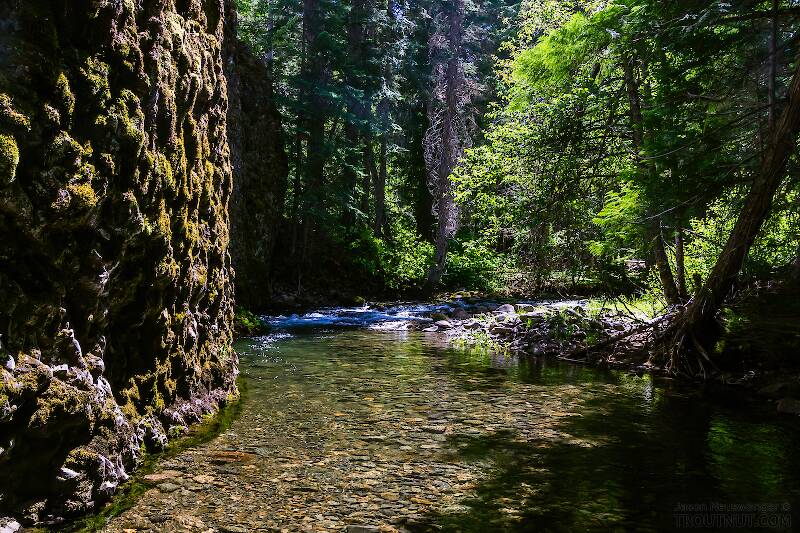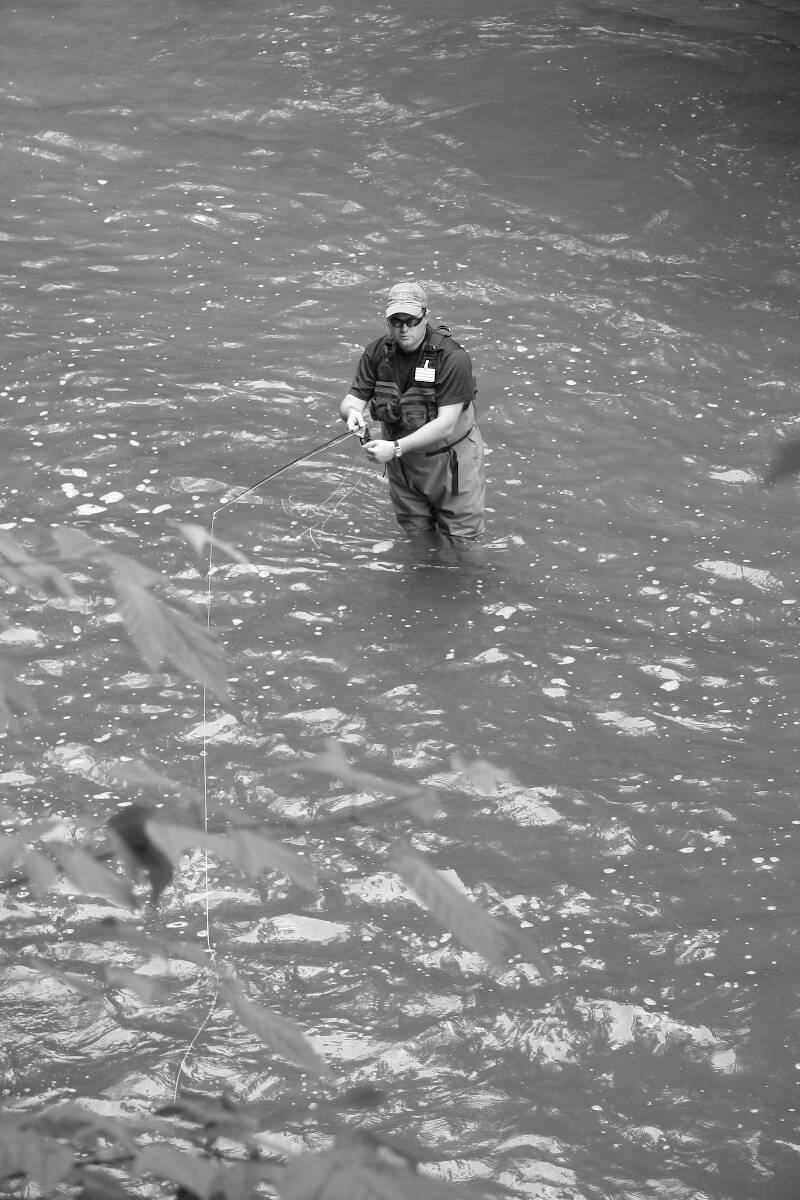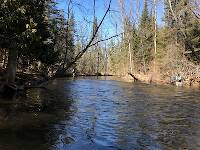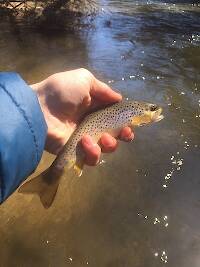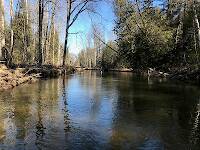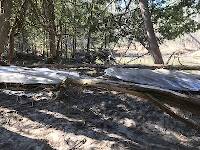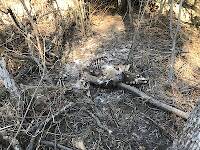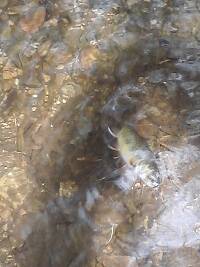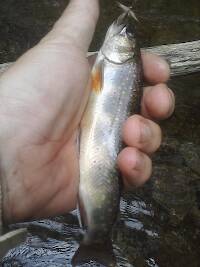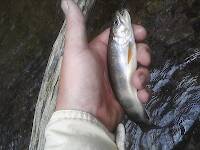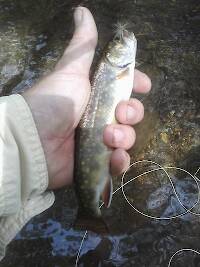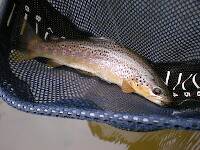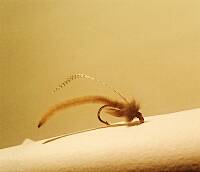
Salmonflies
Pteronarcys californica
The giant Salmonflies of the Western mountains are legendary for their proclivity to elicit consistent dry-fly action and ferocious strikes.
Featured on the forum

This is the first of it's family I've seen, collected from a tiny, fishless stream in the Cascades. The three species of this genus all live in the Northwest and are predators that primarily eat stonefly nymphs Merritt R.W., Cummins, K.W., and Berg, M.B. (2019).

Troutnut is a project started in 2003 by salmonid ecologist Jason "Troutnut" Neuswanger to help anglers and
fly tyers unabashedly embrace the entomological side of the sport. Learn more about Troutnut or
support the project for an enhanced experience here.
Butch28 on Jul 14, 2009July 14th, 2009, 1:51 pm EDT
i know pretty much the basics and have practice a good bit.now what is a good fly to use this time of yr?also should i use a wet or dry fly?maybe could even show me some pics and what size works best.i fish mostly in PA
Martinlf on Jul 14, 2009July 14th, 2009, 6:43 pm EDT
Try an ant, either wet or dry. Either way, they should be fished dead drift, without drag. Wet you will basically be fishing the fly like a nymph, on the bottom.
"He spread them a yard and a half. 'And every one that got away is this big.'"
--Fred Chappell
--Fred Chappell
Shawnny3 on Jul 15, 2009July 15th, 2009, 1:08 am EDT
A pheasant tail nymph, or something similar, in sizes ranging from 16-20, can be a killer fly in summer, especially if an evening hatch kicks in (but a little nymph will often fish well regardless).
At the risk of self-promoting, I also recommend my Green Curly Worm, or something similar. It approximates an inchworm or the bright green caddis larvae found in many streams in PA. Louis's suggestion of an ant is a really good one, but I've personally found the ant rather unproductive this year, perhaps because I have usually fished it in tandem with the Curly Worm. Probably because of its bright color, when I tie it on in tandem with another fly, virtually every fish I catch is on the Curly. It produces along the bank (often where you should be fishing in summer, and I mean right up along the bank), swirling around in tricky eddies, in deep holes, fast pocket water... pretty much anywhere.
All three patterns mentioned are really, really easy and quick to tie, and I would recommend doing that instead of paying someone else for them. But then, no one ever saved money (or their sanity) by getting into flytying, so purchase the flies if you must.
-Shawn
At the risk of self-promoting, I also recommend my Green Curly Worm, or something similar. It approximates an inchworm or the bright green caddis larvae found in many streams in PA. Louis's suggestion of an ant is a really good one, but I've personally found the ant rather unproductive this year, perhaps because I have usually fished it in tandem with the Curly Worm. Probably because of its bright color, when I tie it on in tandem with another fly, virtually every fish I catch is on the Curly. It produces along the bank (often where you should be fishing in summer, and I mean right up along the bank), swirling around in tricky eddies, in deep holes, fast pocket water... pretty much anywhere.
All three patterns mentioned are really, really easy and quick to tie, and I would recommend doing that instead of paying someone else for them. But then, no one ever saved money (or their sanity) by getting into flytying, so purchase the flies if you must.
-Shawn
Jewelry-Quality Artistic Salmon Flies, by Shawn Davis
www.davisflydesigns.com
www.davisflydesigns.com
Martinlf on Jul 15, 2009July 15th, 2009, 8:37 am EDT
or something similar
Just couldn't bring yourself to say "green weenie" could you, Shawn?
I'll have to agree with Shawn; his are very good choices. As for ants, Shawn may be forgetting the exploits of the orange ant in the Baree Gorge, though. I've been catching a good number of fish on ants. And beetles, another good summertime option for fishing dry.
"He spread them a yard and a half. 'And every one that got away is this big.'"
--Fred Chappell
--Fred Chappell
Butch28 on Jul 15, 2009July 15th, 2009, 10:53 am EDT
thanks guys you all are alot of help!going out tomorrow morning
Shawnny3 on Jul 15, 2009July 15th, 2009, 12:13 pm EDT
I thought Gonzo would be the first to suggest a beetle - another good one. I have not forgotten the lesson you taught at the Gorge that time, Louis, but I am a slow learner and have yet to even fish the orange ant. Maybe I'll go whip some up and try them the next time the black one doesn't produce. I hadn't noticed that you neglected to mention color in your post.
As for the quote, it was hard enough to bring myself to type the words, "or something similar." I'm just trying to observe Jason's rule regarding filthy language. Of course, those rules never meant much to you, Louis. Heck, you've even been guilty of haiku. But you won't drag me into the gutter.
-Shawn
As for the quote, it was hard enough to bring myself to type the words, "or something similar." I'm just trying to observe Jason's rule regarding filthy language. Of course, those rules never meant much to you, Louis. Heck, you've even been guilty of haiku. But you won't drag me into the gutter.
-Shawn
Jewelry-Quality Artistic Salmon Flies, by Shawn Davis
www.davisflydesigns.com
www.davisflydesigns.com
Butch28 on Jul 15, 2009July 15th, 2009, 3:05 pm EDT
i hate to be to picky,but do you guys mind posting some pics when you guys are saying what to use?being new to it i can pickup a lil faster with pics if not thats cool i'm sure i'll figure out what they are.this is my first yr trout fishing and i'm having a blast.i have caught many on my open face pfluger reel so now i am stepping up to the fly rod that my fiance' has got me.never thought this trout fishing could be this fun!after i get good with it think i am going to try to catch me some bass with it
CaseyP on Jul 15, 2009July 15th, 2009, 4:22 pm EDT
Butch,
you can Google the name of the fly (add +fly fishing or you'll get some amazingly odd answers) and you'll get a list of links to try. another quick source is a fly tying book of basic flies from the library. another is one of the fly sellers that advertise on this site and others--their online catalogs are nifty.
these suggestions are made not because we're lazy around here, but because the pictures are better than average, and some even come with tying instructions for when that part of fly fishing bites you unawares.
you can Google the name of the fly (add +fly fishing or you'll get some amazingly odd answers) and you'll get a list of links to try. another quick source is a fly tying book of basic flies from the library. another is one of the fly sellers that advertise on this site and others--their online catalogs are nifty.
these suggestions are made not because we're lazy around here, but because the pictures are better than average, and some even come with tying instructions for when that part of fly fishing bites you unawares.
"You can observe a lot by watching." Yogi Berra
Martinlf on Jul 16, 2009July 16th, 2009, 8:08 am EDT
Hey Shawn, you're hard to corrupt, but I can keep trying, can't I? Just had to kid you a bit. Caught a nice fish today on the orange ant.
Butch, Casey's suggestion is a very good one. I don't have a camera, but if you Google images of "ant fly" or any other fly you will get lots of photos.
Butch, Casey's suggestion is a very good one. I don't have a camera, but if you Google images of "ant fly" or any other fly you will get lots of photos.
"He spread them a yard and a half. 'And every one that got away is this big.'"
--Fred Chappell
--Fred Chappell
Softhackle on Jul 16, 2009July 16th, 2009, 10:40 am EDT
Snipe and Pheasant
Have a look at this pattern, but instead of pheasant tail fibers, try using fibers from the brown section of a turkey tail. It's great for Isonychia. Another good one is my Claret Flymph. Both these are wingless wets and can be fished in the film tied on light wire hooks or deeper on wet fly hooks.
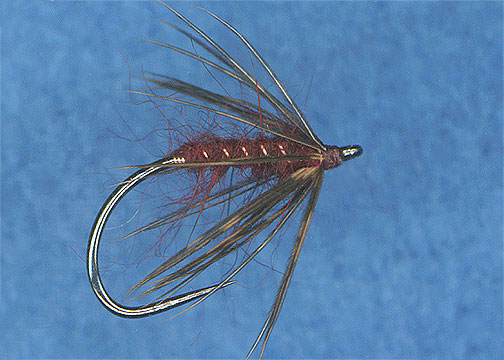
Claret Flymph
Hook: Grip 1472BL or standard wet or dry hook #12-18
Thread: Brown Uni-Thread
Hackle: Dark brown Speckled Hen
Ribbing and tag: Fine copper wire
Body: Claret/Maroon colored rabbit, dubbed Leisenring style on Red Uni-Thread
Terrestrials, as mentioned are also excellent right now. Ants, beetles and crickets are great.
Mark
Have a look at this pattern, but instead of pheasant tail fibers, try using fibers from the brown section of a turkey tail. It's great for Isonychia. Another good one is my Claret Flymph. Both these are wingless wets and can be fished in the film tied on light wire hooks or deeper on wet fly hooks.

Claret Flymph
Hook: Grip 1472BL or standard wet or dry hook #12-18
Thread: Brown Uni-Thread
Hackle: Dark brown Speckled Hen
Ribbing and tag: Fine copper wire
Body: Claret/Maroon colored rabbit, dubbed Leisenring style on Red Uni-Thread
Terrestrials, as mentioned are also excellent right now. Ants, beetles and crickets are great.
Mark
"I have the highest respect for the skilled wet-fly fisherman, as he has mastered an art of very great difficulty." Edward R. Hewitt
Flymphs, Soft-hackles and Spiders: http://www.troutnut.com/libstudio/FS&S/index.html
Flymphs, Soft-hackles and Spiders: http://www.troutnut.com/libstudio/FS&S/index.html
Shawnny3 on Jul 16, 2009July 16th, 2009, 11:12 pm EDT
Mark's suggestion of softhackles is good on a number of levels. They're easy to tie, imitate lots of things fish eat (so they're good to try if you don't really know what to try), and are easy for the beginner to fish because a perfect dead-drift presentation often isn't needed for them to fish well.
Quite common around here this time of year are small crane flies, Size 18 or so, ranging from orange to yellow. A softhackle in the correct size and color would be a nice imitation of drowned adults.
-Shawn
Quite common around here this time of year are small crane flies, Size 18 or so, ranging from orange to yellow. A softhackle in the correct size and color would be a nice imitation of drowned adults.
-Shawn
Jewelry-Quality Artistic Salmon Flies, by Shawn Davis
www.davisflydesigns.com
www.davisflydesigns.com
Flatstick96 on Jul 17, 2009July 17th, 2009, 6:10 am EDT
At the risk of stating the obvious, my advice would be to keep it as simple as possible (at least at first), especially if you want to tie your own (which I think you'll really enjoy).
The beauty of pursuits like fly-fishing and fly-tying is that they offer almost infinite levels of complexity and expense, and each individual can decide what level of complexity or expense suits them best; I am of the opinion that many fly-fishermen are a lot like golfers in that they tend to over complicate things (and over spend), but that's just my opinion. Anyhow, the point is that just because others choose to complicate their approach to fly-fishing, or spend a crapload on money on it, it doesn't mean this pursuit HAS to be complicated or expensive. So, do yourself (and your wallet) a favor and at least START OUT simple.
There have already been several useful suggestions of simple flies (just about all of which are sub-surface flies, which doesn't surprise me since that's where you'll likely catch most of your fish). I'll add three more to the list: Walt's Worm, Muskrat, and March Brown Spider.
I suspect you can buy an inexpensive kit of tying tools, and the materials needed to tie a bountiful supply of the 10 or so flies listed here, for well under $100. And I also suspect that you could catch trout on damned near any stream in PA with nothing more in your box than the very simple patterns listed here.
For more information on a lot of this stuff (and detailed tying info - with pictures - on several of the patterns listed in this thread) go here and read the articles:
http://www.flyfishersparadise.com/articles_archive.php
If you want more information on Shawnny's worm flies that he referenced above, go to his site: www.davisflydesigns.com and look in the "what's new" section.
The beauty of pursuits like fly-fishing and fly-tying is that they offer almost infinite levels of complexity and expense, and each individual can decide what level of complexity or expense suits them best; I am of the opinion that many fly-fishermen are a lot like golfers in that they tend to over complicate things (and over spend), but that's just my opinion. Anyhow, the point is that just because others choose to complicate their approach to fly-fishing, or spend a crapload on money on it, it doesn't mean this pursuit HAS to be complicated or expensive. So, do yourself (and your wallet) a favor and at least START OUT simple.
There have already been several useful suggestions of simple flies (just about all of which are sub-surface flies, which doesn't surprise me since that's where you'll likely catch most of your fish). I'll add three more to the list: Walt's Worm, Muskrat, and March Brown Spider.
I suspect you can buy an inexpensive kit of tying tools, and the materials needed to tie a bountiful supply of the 10 or so flies listed here, for well under $100. And I also suspect that you could catch trout on damned near any stream in PA with nothing more in your box than the very simple patterns listed here.
For more information on a lot of this stuff (and detailed tying info - with pictures - on several of the patterns listed in this thread) go here and read the articles:
http://www.flyfishersparadise.com/articles_archive.php
If you want more information on Shawnny's worm flies that he referenced above, go to his site: www.davisflydesigns.com and look in the "what's new" section.
Shawnny3 on Jul 17, 2009July 17th, 2009, 6:37 am EDT
As far as dries go, it's hard to beat an Adams for starters. This time of year an Elk Hair Caddis might be good, too, but I'd start with an Adams.
-Shawn
-Shawn
Jewelry-Quality Artistic Salmon Flies, by Shawn Davis
www.davisflydesigns.com
www.davisflydesigns.com
GoofusBug
Posts: 31
Posts: 31
GoofusBug on Jul 18, 2009July 18th, 2009, 2:07 pm EDT
This time of year, I am almost 100% terrestrials. Hoppers, crickets, ants, beetles. Partly because they work and partly because I love the lusty strikes the big browns deliver topwater.
Jmd123 on Jul 22, 2009July 22nd, 2009, 4:43 pm EDT
I'll back Shawn up on the Adams & Elk Hair Caddis - two of my favorite dries that will both catch far more than trout. However, as a newbie, I highly recommend Woolly Buggers. Size 6 through 10 is mostly what I use, and any color of the rainbow will work under the right circumstances - for trout, try black, brown, olive, and purple. (For bass and pafish, if you are so inclined, I think chartreuse is best!) Besides this Butch, if you ever want to get into tying your own, Woolly Buggers are easy - first fly I ever learned to tie - and they are DEADLY on ALL fish species. Take a look in the catalogs - Cabelas, Orvis, Feather-Craft, etc. - and your local fly shop. There is even a book out called Woolly Wisdom on the innumerable variationsa on the Woolly Bugger and Woolly Worm.
Also, grasshopper imitations are great from mid-summer to fall. My favorite is a size 10.
Good luck and tight lines!
Jonathon
Also, grasshopper imitations are great from mid-summer to fall. My favorite is a size 10.
Good luck and tight lines!
Jonathon
No matter how big the one you just caught is, there's always a bigger one out there somewhere...
Quick Reply
Related Discussions
Topic
Replies
Last Reply
Re: Identification of a possible Cordulegaster Dragonfly Nymph
In Cordulegaster Dragonfly Nymph by IanB
In Cordulegaster Dragonfly Nymph by IanB
6
Feb 10, 2017
by Taxon
by Taxon

